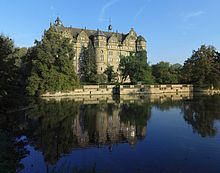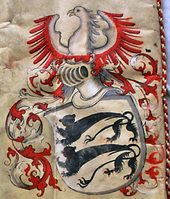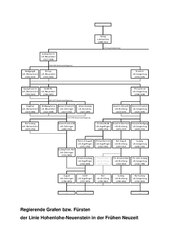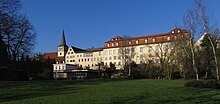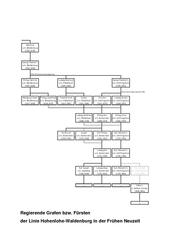Hohenlohe (noble family)
Hohenlohe is a Franconian noble family of the high nobility . His domain extended over the Hohenlohe plain, later named after him, between Kocher , Tauber and Jagst . Despite repeated partitions in the 13th and 15th centuries and donations to the Teutonic Order (1219), Hohenlohe was able to form an almost closed territory. The Lords of Hohenlohe were raised to the status of imperial counts in 1450 , from the middle of the 18th century the area and its rulers were princely .
History of the House of Hohenlohe
Family name and origin

The home country of the house is the former Taubergau and Gollachgau . The name Hohenlohe as a family name was the first to use Konrad, one of the three sons of Konrad von Weikersheim , first mentioned in 1153 , in the form of "Hohenlach" or "Holach". This name was later also used by his brothers Heinrich and Albert. It is derived from the no longer existing Hohlach Castle near Uffenheim in Middle Franconia , to which the Lords of Weikersheim had relocated their headquarters. This was probably due to the proximity of Hohlach Castle to the trade routes between Frankfurt , Würzburg and Augsburg . Proof of this assumption is the fact that the Lords of Hohenlohe held the right of escort on the streets there until the 14th century in the Central Franconian areas around the Taubertal .
For the time before Konrad von Hohenlohe, his father Konrad von Weikersheim and his brother Heinrich, there is no reliable evidence. It is considered plausible, but it cannot be proven, that the lords of Weikersheim and later lords of Hohenlohe are of the same tribe as the noble lords of Pfitzingen near Niederstetten . It is possible that the name change occurred when a member of the Weikersheim family married the heiress of an existing family on Hohlach. Other theories try to prove that the Hohenlohe family descended from the dukes of Franconia or from the lords of Mergentheim . In 1219 the brothers Andreas, Friedrich and Heinrich von Hohenlohe, who returned to Damiette from the crusade , donated property and rights to the Teutonic Order as well as their castle in Mergentheim, making it the Teutonic Order Castle Mergentheim .
First division
Of the three sons of Konrad von Weikersheim, Konrad and Albrecht died childless. Heinrich von Hohenlohe, the third son, had five sons, of whom Andreas, Heinrich and Friedrich entered the Teutonic Order and thus the clergy. Gottfried and Konrad were at the head of the house in the Staufer period and were followers of Emperor Friedrich II , after their uncles Konrad and Albrecht had appeared several times at the Reichstag in the 12th century and Albrecht had participated in the Third Crusade of 1189. Frederick II rewarded the two brothers for their services by granting counties as fiefdoms. Konrad von Hohenlohe received the County of Molise in Abruzzo as a fief in December 1229 , but had to have it as early as 1230 as part of the emperor's removal from the church ban by Pope Gregory IX. give back again. From 1230 Konrad and Gottfried (both individually and together) carried the title Count of Romagna .
A family contract from 1230 regulated, among other things, the delimitation of the communal fiefdom. Konrad received the eastern part, which is now largely in Bavaria, with the main castle in Brauneck . His family branch died out in the male line in 1390, the possessions were lost to the Hohenlohe family. Gottfried received the western part with the ancestral seat Burg Hohlach . In addition, he received rule over Langenburg from Emperor Friedrich II as a Würzburg fiefdom , whose lords had joined the Teutonic Order and had family ties to the Hohenlohe. Gottfried became educator and advisor to King Conrad IV . This allegedly survived a murder plot in Regensburg in 1250, the mastermind of which is said to have been the bishop of Regensburg . King Konrad gave Gottfried as gratitude for his help Regensburg fiefdoms . This also included the bailiwick of the Canons' Monastery of Öhringen, founded in 1037, and the places Neuenstein and Waldenburg . Gottfried's son, Kraft I. von Hohenlohe, expanded his territory through numerous acquisitions of properties belonging to the lower nobility, including Lichteneck Castle with the town of Ingelfingen . His son Kraft II also made numerous enlargements of the area, especially in the area of the middle cooker and the Jagst .
Territory extensions
As a result of this enlargement of the area, there was a territorial rule of Hohenlohe, which went beyond the old form of noble rule with manorial rule and jurisdiction . The Lords of Hohenlohe received money from customs duties and escort rights, they held the right to mint the mint in Öhringen , the right to protect Jews and numerous market rights in Hohenlohe towns. As bailiffs , the Hohenlohe were first in Öhringen and in Kochergau , later for all possessions, owners of jurisdiction. The mayors were also subordinate to them. In 1418, the Roman-German king and later Emperor Sigismund granted Albrecht von Hohenlohe absolute jurisdiction over the entire territory. The Hohenlohe could only be prosecuted by the emperor or an imperial court, while their subjects and servants could only be prosecuted by a Hohenlohe court. Thus all essential rulership rights were in the hands of the Hohenlohe, so that one can speak of a state rule. The Empire earldom had the Hohenlohe but not obtained at the end of the Middle Ages, they were only nobilis vir and not comes .
Imperial Counts
On May 13, 1450 Kraft V. was from the later Emperor Friedrich III. raised to the rank of imperial count, the lending related to the counties Ziegenhain and Nidda , whose lordships were extinct and with whom the Hohenlohe had family ties through marriage. The lending led to a dispute with Landgrave Ludwig I of Hesse , who also asserted claims on the two counties. It was not until 45 years later, at the Diet of Worms in 1495, the dispute was through the Roman-German King I. Maximilian be settled. The Hohenlohe paid the landgrave compensation and retained the title of count, which was now related to the home country. The year 1495 is thus the hour of birth of the County of Hohenlohe and the Counts of Hohenlohe.
reformation
During the Reformation the Hohenlohe family became Protestant , Count Georg I is said to have received the Lord's Supper on his deathbed in 1551 according to Protestant custom. With the church ordinance of 1553, his sons ordered the Augsburg Confession ( Confessio Augustana ) for all pastors and preachers in the county. With the Peace of Augsburg in 1556, the Reformation in Hohenlohe was completed, and the Canons' Monastery of Öhringen was also reformed.
Main land division
The main land division of the house came about in 1555, when the two half-brothers Ludwig Casimir and Eberhard agreed on a division of the home land and the two main lines Hohenlohe- Neuenstein and Hohenlohe- Waldenburg were created. Both lines were named after their ancestral home. Öhringen, which remained in the joint ownership of the two lines, was not affected by the division of land. Numerous other divisions of the lines took place up to 1806. An ideal connection between the rulers was always preserved. This was expressed, among other things, in the fact that the emperor awarded the imperial fiefs to the respective senior of the ruling counts.
After the counts of Gleichen died out in 1631, the Counts of Hohenlohe-Langenburg were given the Thuringian county of Obergleichen with its seat at Ehrenstein Castle in Ohrdruf . In 1663 they divided them up under the lines Hohenlohe-Langenburg and Hohenlohe-Neuenstein. Count Johann Ludwig von Hohenlohe-Langenburg-Gleichen had Bartenau Castle built in Künzelsau in 1679 .
The Hohenlohe area was initially largely spared from the Thirty Years War , but later, due to the fact that the Count of Hohenlohe-Weikersheim supported King Gustav II Adolf of Sweden, the Weikersheim rule was withdrawn.
Only after the Peace of Westphalia in 1648 was the house reinstated in its old rights and received back in full the drafted lordships, which had in the meantime been transferred to the Teutonic Order as a fief. The Peace of Westphalia confirmed the imperial estates and thus also the Hohenlohe their old rights and the high regional authority, so that they could rule like sovereign rulers .
Confessional division of the two main lines
The two main lines split in October 1667 when the two sons of Georg Friedrich II. Von Hohenlohe-Waldenburg-Schillingsfürst, Count Christian (progenitor of the Bartenstein line ) and Ludwig Gustav (progenitor of the Schillingsfürst line ) joined the Roman Catholic family Returned to the church . With the extinction of the Hohenlohe-Waldenburg-Waldenburg line in 1679 and Hohenlohe-Waldenburg- Pfedelbach in 1728, the entire ownership of the main Waldenburg line fell to the Catholic counts.
Imperial Princes
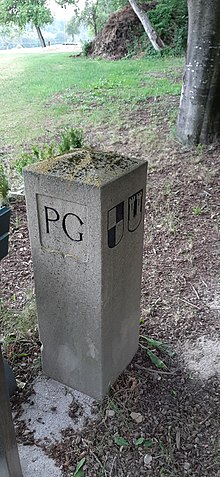
Efforts to be elevated to the rank of imperial princes also contributed to the division of the two lines. On May 21, 1744, Emperor Karl VII raised Imperial Count Philipp Ernst von Hohenlohe-Waldenburg-Schillingsfürst and Imperial Count Karl Philipp von Hohenlohe-Waldenburg-Bartenstein and their descendants to imperial princes. Their parts of the country were only raised to the status of imperial principality on August 14, 1757 by Emperor Franz I. The elevation of the Waldenburg line to princes led to a dispute about priority in the entire house. It was not until January 7, 1764 that the older Neuensteiner line was elevated to the rank of imperial prince by Emperor Franz. The conflicts over the priority in the entire house persisted. It was only in the context of the Öhringen Convention of June 12, 1782, with which Ludwig Friedrich Karl Prince of Hohenlohe-Neuenstein acquired the share of the Waldenburg main line in Öhringen and now became the sole ruler of the residential city , did the princes agree that the hierarchy in the entire house should be determined by the age of the ruling prince.
Mediatization: end of the Hohenlohe state rule
The principalities of Württemberg were mediatized with the Rhine Federation Act in 1806 , and the Schillingsfürst exclave fell to Bavaria .
Acquisition of ownership in Silesia
Prince Friedrich Ludwig zu Hohenlohe-Ingelfingen came into the possession of the Slawentzitz rule in Upper Silesia through marriage in 1782 . In 1804 he also acquired the Landsberg and Koschentin lords . His grandson Hugo, Prince zu Hohenlohe-Öhringen , who held dominion Slawentzitz in 1849, reached their appointment as outdoor caste domination and gained in 1861 with the coronation of William I the title of Duke of Ujest . The duchy, which had its seat in Slawentzitz, united the Fideikommisse Slawentzitz, Ujest and Bitschin with an area of 175 km². With its entry into calamine mining and zinc smelting in Upper Silesia, the Hohenlohe-Oehringen company became one of the world's largest zinc producers.
Hohenlohe Central Archive
The Hohenlohe Central Archive in Schloss Neuenstein is jointly owned by the six Hohenlohe lines and is responsible for all former and still active administrations of the House of Hohenlohe as well as for the bequests of family members.
coat of arms

The Hohenlohe coat of arms first appeared at the beginning of the 13th century: two striding black leopards with bowed tails. They can be seen for the first time on a seal on the oldest Hohenlohe document from 1207. This document attests to the donation of the church in Mergentheim to the Order of St. John by Albert von Hohenlohe, who came into contact with this order through his participation in the crusade with Emperor Friedrich I. Barbarossa .
The coat of arms of the Hohenloher family shows two black leopards standing on top of one another, striding to the right with downcast tails; Originally two silver buffalo horns on the helmet with red and silver covers, each equipped with five golden linden branches on the outside, later a silver phoenix with red flight feathers on the wings.
The motto of those at Hohenlohe is "ex flammis orior" (German: I rise from the flames). This motto goes back to Prince Philipp Ernst zu Hohenlohe-Waldenburg-Schillingsfürst, the builder of Schillingsfürst Castle , who founded the House Order of the Golden Flame in 1754 in order to raise the splendor of the entire Hohenlohe House. His son, Prince Karl Albrecht I zu Hohenlohe-Waldenburg-Schillingsfürst, renewed the order in 1775 with the name House and Knight Order of the Phoenix with the motto "ex flammis orior".
The Order of the Phoenix was only awarded to people of old nobility, from 1793 to 1818 to a total of 59 nobles. The most famous bearer of the Hohenlohe Order of the Phoenix was King Ludwig XVIII. of France .
Lords, Counts and Princes of Hohenlohe
Original line
- Lords of Hohenlohe
- 1192–1209 Heinrich von Hohenlohe (inheritance distribution in Hohenlohe and Hohenlohe-Brauneck )
- Lords of Hohenlohe
- 1209-1266? Gottfried von Hohenlohe (inheritance distribution in Hohenlohe-Weikersheim and Hohenlohe-Uffenheim )
- Hohenlohe-Weikersheim
- 1266–1313 Kraft I. von Hohenlohe (daughter: Agnes von Hohenlohe )
- 1313–1344 Kraft II. Von Hohenlohe
- 1344-1371 force III. from Hohenlohe
- 1371–1429 Albrecht I of Hohenlohe
- 1429–1472 Kraft V. von Hohenlohe (was elevated to Imperial Count on May 14, 1450 by Emperor Friedrich III )
- 1429–1472 Count Kraft V. von Hohenlohe
- 1472–1503 Count Kraft VI. from Hohenlohe
- 1503–1551 Count Georg von Hohenlohe ( main division of the country by his sons into the Neuensteiner line and the Waldenburg line )
- Hohenlohe-Uffenheim
- 1266–1271 Albrecht I of Hohenlohe
- 1271–1290 Godfried I of Hohenlohe-Uffenheim
- 1290–1314 Albrecht II of Hohenlohe
- 1314–1359 Ludwig von Hohenlohe
- 1359–1387 Godfried II of Hohenlohe
- 1387–1412 Johann von Hohenlohe (Hohenlohe-Uffenheim expires)
- Lords of Hohenlohe-Brauneck
- 1209–1249 Conrad I of Hohenlohe, Count of Molise and the Romagne (inheritance distribution in Hohenlohe-Haltbergstetten and Hohenlohe-Brauneck )
- Lords of Hohenlohe-Haltbergstetten
- 1249–1268: Heinrich von Brauneck-Neuhaus
- 1268–1300: Gebhard von Brauneck in Haltbergstetten
- 1300–1332: Ulrich von Brauneck in Haltbergstetten
- 1332–1347: Ulrich II von Brauneck in Haltbergstetten
- 1347-1367: Ulrich III. from Brauneck in Haltbergstetten
- 1367–1381: Ulrich IV. Von Brauneck in Haltbergstetten (Hohenlohe-Haltbergstetten became extinct)
- Lords of Hohenlohe-Brauneck
- 1249–1273 Godfried I of Hohenlohe (possibly identical to Godfried II.)
- 1273–1306 Godfried II of Brauneck in Brauneck and the Büdinger estates († 1312)
- 1306-1354 Godfried III. from Brauneck in Brauneck
- 1354–1368 Godfried IV. Von Brauneck in Brauneck
- 1368–1390 Conrad IV. Von Brauneck in Creglingen (Brauneck expires)
Neuensteiner line
- Count of Hohenlohe-Neuenstein
- 1551–1568 Count Ludwig Casimir von Hohenlohe-Neuenstein
- 1568–1586 joint government of the sons Albrecht, Wolfgang, Philipp and Friedrich, 1586 inheritance distribution in Hohenlohe-Neuenstein (Philipp), Hohenlohe-Langenburg (and Kirchberg) (Friedrich) and Hohenlohe-Weikersheim (Wolfgang II.)
- 1586–1590 Count Friedrich von Hohenlohe-Langenburg, Langenburg falls to Wolfgang II, Kirchberg to Philipp
- 1586–1606 Count Philipp von Hohenlohe-Neuenstein, Neuenstein and Kirchberg fall to Wolfgang II.
- 1568–1610 Count Wolfgang II of Hohenlohe - (Neuenstein-) Weikersheim, the last time the new Steiner line was united in one hand.
- 1610 Distribution of inheritance in Hohenlohe-Neuenstein , Hohenlohe-Langenburg and Hohenlohe-Weikersheim
- 1610–1645 Count Georg Friedrich von Hohenlohe-Weikersheim
- 1610–1641 Count Kraft VII. Von Hohenlohe-Neuenstein
-
1645–1677 joint government of the sons of Kraft VII, Johann Friedrich, Kraft Magnus, Siegfried, Wolfgang Julius , Johann Ludwig and Philipp Maximilian Johann, also with the help of their mother Sophia, née. Countess Palatine near the Rhine, 1677 inheritance division in Hohenlohe-Oehringen , Hohenlohe-Weikersheim (only one generation 1677–1684 under Count Siegfried), Hohenlohe-Künzelsau (only one generation 1677–1689 under Count Johann Ludwig) and Hohenlohe-Neuenstein (only one generation 1677 –1698 under Count Wolfgang Julius), ownership falls to Hohenlohe- (Neuenstein-) Oehringen
- Counts and princes of Hohenlohe- (Neuenstein-) Oehringen (until 1805)
- 1677–1702 Count Johann Friedrich I of Hohenlohe- (Neuenstein-) Oehringen
- 1702 joint government of the sons Karl Ludwig and Johann Friedrich II., 1708 inheritance distribution in Hohenlohe- (Neuenstein-) Oehringen and Hohenlohe-Weikersheim (only one generation 1708–1756 under Count Karl Ludwig)
- 1708–1765 Count Johann Friedrich II. Von Hohenlohe- (Neuenstein-) Oehringen; on January 7, 1764 raised to the rank of prince
- 1765–1805 Prince Friedrich Ludwig Friedrich Carl zu Hohenlohe- (Neuenstein-) Oehringen
- Line extinguished, Oehringen falls to Prince Friedrich Ludwig zu Hohenlohe-Ingelfingen (continuing the name Hohenlohe-Oehringen)
- Count of Hohenlohe-Langenburg
- 1610–1628 Count Philipp Ernst von Hohenlohe-Neuenstein
- 1628–1699 Count Heinrich Friedrich von Hohenlohe-Langenburg and Gleichen
- 1699 Distribution of inheritance in Hohenlohe-Langenburg , Hohenlohe-Ingelfingen and Hohenlohe-Kirchberg
-
Counts and princes of Hohenlohe-Langenburg
- 1699–1715 Count Albrecht Wolfgang von Hohenlohe-Langenburg
- 1715–1764 Count Ludwig von Hohenlohe-Langenburg , raised to the rank of prince on January 7, 1764
- 1764–1765 Prince Ludwig of Hohenlohe-Langenburg (1696–1765)
- 1765–1789 Prince Christian Albrecht Ludwig zu Hohenlohe-Langenburg (1726–1789)
- 1789–1825 Prince Carl Ludwig zu Hohenlohe-Langenburg (1762–1825)
- Heads of the House of Hohenlohe-Langenburg
- 1825–1860 Prince Ernst Christian Carl zu Hohenlohe-Langenburg (1794–1860)
- 1860 Prince Carl Ludwig zu Hohenlohe-Langenburg (1829–1907), ancestor of the Princes von Weikersheim , renounced his rights in the Hohenlohe-Langenburg house in 1860 in favor of his younger brother
- 1860–1913 Prince Hermann Ernst Franz Bernhard zu Hohenlohe-Langenburg (1832–1913)
- 1913–1918 Prince Ernst Wilhelm Friedrich Carl Maximilian zu Hohenlohe-Langenburg (1863–1950)
- 1918–1950 Ernst Wilhelm Friedrich Carl Maximilian Prince of Hohenlohe-Langenburg (1863–1950)
- 1950–1960 Gottfried Hermann Alfred Paul Maximilian Viktor zu Hohenlohe-Langenburg (1897–1960)
- 1960–2004 Kraft Alexander Ernst Ludwig Georg Emich zu Hohenlohe-Langenburg (1935–2004)
- since 2004 Philipp Gottfried Alexander zu Hohenlohe-Langenburg (* 1970) (in Crailsheim)
- Duke of Medinaceli
- Marco Prinz zu Hohenlohe-Langenburg (Spanish don Marco de Hohenlohe-Langenburg y Medina ) (* 1962–2016), 19th Duque de Medinaceli , inherited the Spanish title from his mother Ana de Medina y Fernández de Córdoba, Condesa de Ofalia, from their mother Victoria Eugenia Fernández de Córdoba , 18th Duquesa de Medinaceli etc.
- Victoria Elisabeth Princess of Hohenlohe-Langenburg ( span . Doña Victoria Elisabeth von Hohenlohe-Langenburg ) (* 1997), the 20th Duchess of Medinaceli etc., head of the casa de Medinaceli , tenfold Grande de España ; is considered the person with the most nobility titles worldwide (43 titles in total) Counts and princes, heads of Hohenlohe-Ingelfingen after 1806
- 1699–1743 Count Christian Kraft zu Hohenlohe-Ingelfingen
- 1743–1781 Count Philipp zu Hohenlohe-Ingelfingen, on January 7, 1764 raised to the rank of prince
- 1764–1781 Prince Philipp zu Hohenlohe-Ingelfingen
- 1781–1796 Prince Heinrich August zu Hohenlohe-Ingelfingen
- 1796–1806 Prince Friedrich Ludwig zu Hohenlohe-Ingelfingen (resigned 1806, † 1818), Prussian general
- 1818–1873 Prince Adolf zu Hohenlohe-Ingelfingen , German military and politician
- 1873-1892 Kraft Karl August zu Hohenlohe-Ingelfingen , Prussian general
- Princes of Hohenlohe-Oehringen (since 1805)
- 1805–1806 Prince Friedrich Ludwig zu Hohenlohe-Ingelfingen
- 1806–1849 Prince August zu Hohenlohe-Öhringen (1784–1853), resigned in 1849.
- 1849–1861 Prince Hugo zu Hohenlohe-Öhringen , raised in 1861 to Duke of Ujest .
- Princes of Hohenlohe-Oehringen and dukes of Ujest
- 1861–1897 Prince Hugo zu Hohenlohe-Öhringen, 1st Duke of Ujest (1816–1897)
- 1897–1918 Prince Christian Kraft zu Hohenlohe-Öhringen, 2nd Duke of Ujest (1848–1926)
- Heads of the House of Hohenlohe-Oehringen
- 1918–1926 Christian Kraft Prince of Hohenlohe-Öhringen (1848–1926)
- 1926–1955 Johann (Hans) zu Hohenlohe-Oehringen (1858–1955)
- 1955–1962 August zu Hohenlohe-Oehringen (1890–1962)
- 1962– Kraft Hans Konrad zu Hohenlohe-Oehringen (1933–) (at Neuenstein Castle )
- Counts and princes of Hohenlohe-Kirchberg
- 1699–1737 Count Friedrich Eberhard zu Hohenlohe-Kirchberg
- 1737–1767 Count Karl August zu Hohenlohe-Kirchberg, raised to Prince in 1764
- 1764–1767 Prince Karl August zu Hohenlohe-Kirchberg
- 1767–1819 Prince Christian Friedrich Karl zu Hohenlohe-Kirchberg
- 1819–1836 Prince Ludwig zu Hohenlohe-Kirchberg
- 1836–1861 Prince Karl zu Hohenlohe-Kirchberg
Waldenburg line
- Count of Hohenlohe-Waldenburg
- 1551–1570 Count Eberhard von Hohenlohe in Waldenburg ∞ Agathe von Tübingen
- 1570–1600 Count Georg Friedrich I of Hohenlohe-Waldenburg
- 1600–1635 Count Georg Friedrich II of Hohenlohe-Waldenburg
- 1615 Distribution of inheritance in Hohenlohe-Waldenburg and Hohenlohe-Pfedelbach
- Count of Hohenlohe- Pfedelbach
- 1600–1650 Count Ludwig Eberhard von Hohenlohe-Pfedelbach (born January 19, 1590; † 1650)
- 1650–1681 Count Friedrich Kraft von Hohenlohe-Pfedelbach (* November 27, 1623; † April 7, 1681)
- 1681–1685 Count Hezekiah of Hohenlohe-Pfedelbach (8 September 1631 - 6 February 1685)
- 1685–1728 Count Ludwig Gottfried von Hohenlohe-Pfedelbach (* December 6, 1668 - September 18, 1728) (Hohenlohe-Pfedelbach expires and Hohenlohe-Bartenstein)
- Count of Hohenlohe-Waldenburg-Schillingsfürst
- 1635–1697 Count Ludwig Gustav zu Hohenlohe-Waldenburg-Schillingsfürst
- 1688 Distribution of inheritance in Hohenlohe-Waldenburg-Bartenstein and Hohenlohe-Waldenburg-Schillingsfürst
- Counts and Princes of Hohenlohe-Bartenstein (until 1844)
- 1688–1729 Philipp Karl zu Hohenlohe-Bartenstein , imperial chamber judge in Wetzlar , became master of the newly created county of Bartenstein by drawing lots
- 1729–1763 Count Karl Philipp zu Hohenlohe-Waldenburg-Bartenstein (raised to prince on May 21, 1744 for his services to the emperor), judge of the Reich Chamber of Commerce in Wetzlar
- Princes of Hohenlohe-Bartenstein
- 1763–1798 Prince Ludwig Leopold zu Hohenlohe-Bartenstein († 1799, resigned in 1798 after the death of his wife, then inheritance in Hohenlohe-Bartenstein and Hohenlohe-Jagstberg )
- 1798–1806 Prince Ludwig Aloys zu Hohenlohe-Waldenburg-Bartenstein , handed over government to his son in 1806, became Marshal of France in 1823 , † 1829
- 1806–1844 Prince Karl August zu Hohenlohe-Waldenburg-Bartenstein (the line expires with his death and coincides again with Hohenlohe-Jagstberg )
- Princes of Hohenlohe-Jagstberg (since 1844 Hohenlohe-Bartenstein and Jagstberg)
- 1798–1833 Prince Karl Joseph zu Hohenlohe-Jagstberg
- 1833–1850 Prince Ludwig Albrecht Konstantin zu Hohenlohe-Jagstberg (since 1844 Prince of Hohenlohe-Bartenstein and Jagstberg)
- 1850–1877 Prince Karl Ludwig Konstantin zu Hohenlohe-Bartenstein
- 1877–1918 Prince Johannes Friedrich zu Hohenlohe-Bartenstein (and Jagstberg, since 1898 after the death of his childless uncle Albert, Prince of Hohenlohe-Jagstberg)
- Heads of Hohenlohe-Bartenstein and Jagstberg (from 1918)
- 1918–1921 Johannes Friedrich Prince of Hohenlohe-Bartenstein and Jagstberg
- Heads of the Hohenlohe- Bartenstein house
- 1921–1950 Karl zu Hohenlohe-Bartenstein
- 1950–2019 Ferdinand Michael zu Hohenlohe-Bartenstein
- since 2019 Maximilian zu Hohenlohe-Bartenstein (at Bartenstein Castle )
- Heads of the Hohenlohe-Jagstberg house
- 1921–1996 Albrecht zu Hohenlohe-Jagstberg
- since 1996 Alexander zu Hohenlohe-Jagstberg (at Schloss Haltebergstetten )
- Counts and princes of Hohenlohe-Waldenburg-Schillingsfürst
- 1697–1759 Count Philipp Ernst zu Hohenlohe-Waldenburg-Schillingsfürst , appointed Prince of Hohenlohe-Waldenburg-Schillingsfürst on May 21, 1744
- 1759–1793 Prince Karl Albrecht I of Hohenlohe-Waldenburg-Schillingsfürst (* 1719; † 1793)
- 1793–1796 Prince Karl Albrecht II of Hohenlohe-Waldenburg-Schillingsfürst (* 1742; † 1796)
- 1796–1839 Prince Karl Albrecht III. zu Hohenlohe-Waldenburg-Schillingsfürst (* 1776, resigned 1839, † 1843)
- 1807 Distribution of inheritance in Hohenlohe-Waldenburg-Schillingsfürst (Württemberg line) and Hohenlohe-Schillingsfürst-Schillingsfürst (Bavarian line)
- Princes of Hohenlohe-Waldenburg-Schillingsfürst (in Württemberg )
- 1839–1884 Prince Friedrich Karl I Joseph zu Hohenlohe-Waldenburg-Schillingsfürst
- 1884–1886 Prince Nikolaus zu Hohenlohe-Waldenburg-Schillingsfürst
- 1886–1918 Prince Friedrich Karl II of Hohenlohe-Waldenburg-Schillingsfürst
- Heads of the House of Hohenlohe-Waldenburg-Schillingsfürst
- 1918–1924 Friedrich Karl (II.) Prince of Hohenlohe-Waldenburg-Schillingsfürst
- 1924–1982 Friedrich Karl III. to Hohenlohe-Waldenburg-Schillingsfürst
- 1982-2017 Friedrich Karl IV. Zu Hohenlohe-Waldenburg-Schillingsfürst (at Waldenburg Castle )
- since 2017 Felix zu Hohenlohe-Waldenburg-Schillingsfürst
- Prince of Hohenlohe-Schillingsfürst (in Bavaria )
- 1807–1841 Prince Franz Joseph zu Hohenlohe-Schillingsfürst
- 1841–1845 Philipp Ernst Prince of Hohenlohe-Schillingsfürst
- 1845–1846 Prince Victor zu Hohenlohe-Schillingsfürst renounced Hohenlohe-Schillingsfürst in 1846 in favor of his younger brother and became Duke of Ratibor (see below)
- 1846–1901 Prince Chlodwig zu Hohenlohe-Schillingsfürst
- 1901–1915 Philipp Ernst Prince of Hohenlohe-Schillingsfürst
- 1915–1918 Moritz Fürst zu Hohenlohe-Schillingsfürst
- Heads of the House of Hohenlohe-Schillingsfürst
- 1918–1940 Moritz Fürst zu Hohenlohe-Schillingsfürst
- 1940–1965 Franz Josef zu Hohenlohe-Schillingsfürst
- 1965–2005 Karl-Albrecht zu Hohenlohe-Schillingsfürst
- 2005– Constantin zu Hohenlohe-Schillingsfürst (at Schillingsfürst Castle )
Dukes of Ratibor and Princes of Corvey
see Duchy of Ratibor
From the royal Prussian chamber property at Ratibor in Upper Silesia, which was expanded as a secularized church property by (1810), the rule Ratibor arose, which was acquired in 1812 by the Prince Elector of Hesse-Kassel . In 1820, the rule of Ratibor was elevated to a media principality , which Landgrave Viktor Amadeus of Hesse-Rotenburg (1779–1834) got together with the Corvey Monastery in Westphalia as a replacement for areas left of the Rhine that had been ceded to France. The childless landgrave had decided to bequeath his property - Ratibor in Silesia, Corvey in Westphalia and Treffurt in the Erfurt administrative district - to the two eldest sons of his brother-in-law, Prince Franz-Joseph zu Hohenlohe-Schillingsfürst (1787–1841). In an inheritance contract, his three sons had divided up the estate of their father and uncle in such a way that the eldest, Hereditary Prince Viktor, took control of Ratibor, Clovis (who later became Chancellor) took control of Corvey and Philipp Ernst took control of Schillingsfürst. In 1840 Viktor , who resided in the secularized monastery of Rauden , received the hereditary title Duke of Ratibor from the King of Prussia. When Philipp Ernst died in 1845 without male descendants, Clovis ceded the Corvey reign to his brother Viktor and took over his father's family house, Schillingsfürst, with the title of prince. In 1894 the wife of Duke Viktor II. Amadeus von Ratibor , born Countess Breuner , inherited the Lower Austrian estates of her male family, Grafenegg , Neuaigen and Asparn , which, together with Corvey, are still owned by the ducal family.
-
Victor I. Duke of Ratibor (since 1840), 1st Prince of Corvey, Prince of Hohenlohe-Schillingsfürst (1818–1893), German nobleman and politician
-
Victor II Amadeus Duke of Ratibor , 2nd Prince of Corvey, Prince of Hohenlohe-Schillingsfürst (1847–1923), German nobleman and Prussian politician
-
Victor III. Duke of Ratibor , 3rd Prince of Corvey, Prince of Hohenlohe-Schillingsfürst-Breunner-Enkevoirth (1879–1945), landowner, farmer and forester
-
Franz Albrecht Metternich-Sándor (1920–2009), farmer and forester; (historical nobility:, 4th Duke of Ratibor, 4th Prince of Corvey, Prince of Hohenlohe-Schillingsfürst)
- Viktor Herzog von Ratibor (* 1964), farmer and forester; (historical nobility: Viktor IV., 5th Duke of Ratibor, 5th Prince of Corvey, Prince of Hohenlohe-Schillingsfürst-Breunner-Enkevoirth)
-
Franz Albrecht Metternich-Sándor (1920–2009), farmer and forester; (historical nobility:, 4th Duke of Ratibor, 4th Prince of Corvey, Prince of Hohenlohe-Schillingsfürst)
-
Victor III. Duke of Ratibor , 3rd Prince of Corvey, Prince of Hohenlohe-Schillingsfürst-Breunner-Enkevoirth (1879–1945), landowner, farmer and forester
-
Victor II Amadeus Duke of Ratibor , 2nd Prince of Corvey, Prince of Hohenlohe-Schillingsfürst (1847–1923), German nobleman and Prussian politician
Castle (former monastery) Rauden near Ratibor, Upper Silesia
Corvey Castle (former abbey) , East Westphalia
Grafenegg Castle , Lower Austria
Castle Neuaigen , Lower Austria
Other namesake of the family


- Heinrich von Hohenlohe (around 1200–1249), Grand Master of the Teutonic Order
- Gottfried von Hohenlohe (1265–1309), Grand Master of the Teutonic Order
- Gottfried III. von Hohenlohe († 1322), Bishop of Würzburg
- Albrecht II of Hohenlohe († 1372), Bishop of Würzburg
- Friedrich I von Hohenlohe († 1352), Prince-Bishop of Bamberg
- Georg von Hohenlohe (around 1350–1423), Prince-Bishop of Passau
- Johannes von Hohenlohe (around 1370–1412), knight
- Wolfgang Julius von Hohenlohe-Neuenstein (1622–1698), Field Marshal General
- Christian von Hohenlohe-Waldenburg-Bartenstein (1627–1675), Bavarian governor in Neumarkt
- Friedrich Wilhelm zu Hohenlohe-Kirchberg (1732–1796), Austrian Feldzeugmeister
- Joseph Christian Franz zu Hohenlohe-Waldenburg-Bartenstein (1740–1817), Prince-Bishop of Breslau
- Franz Karl Joseph zu Hohenlohe-Waldenburg-Schillingsfürst (1745–1819), auxiliary bishop and bishop of Augsburg
- Friedrich Karl Wilhelm von Hohenlohe-Ingelfingen (1752–1815), Imperial Field Marshal Lieutenant, Knight of the Maria Theresa Order, Prince of Hohenlohe-Ingelfingen
- Georg Friedrich Heinrich von Hohenlohe-Ingelfingen (1757–1803), Prussian Major General, Chief of Infantry Regiment No. 31
- Louise Eleonore zu Hohenlohe-Langenburg (1763–1837), Duchess of Saxony-Meiningen
- Alexander zu Hohenlohe-Waldenburg-Schillingsfürst (Prince Leopold Alexander Franz Emmerich zu Hohenlohe-Waldenburg-Schillingsfürst; 1794–1849), Catholic clergyman and faith healer, titular bishop of Sardika and abbot of St. Michael in Gaborjan
- Friedrich Karl I. zu Hohenlohe-Waldenburg-Schillingsfürst (1814-1884), Prince of the Hohenlohe-Waldenburg-Schillingsfürst, heraldist and sphragistician
- Katharina zu Hohenlohe-Waldenburg-Schillingsfürst (1817–1893), German nobleman, founder of the Beuron Abbey
- Chlodwig zu Hohenlohe-Schillingsfürst (1819–1901) Chancellor of the German Empire and Prussian Prime Minister, brother of Viktor I, Duke of Ratibor
- Carl zu Hohenlohe-Ingelfingen (1820–1890), German civil servant and politician, MdR
- Gustav Adolf zu Hohenlohe-Schillingsfürst (1823–1896), brother of Chlodwig, cardinal, 1879–1884 Bishop of Albano
- Friedrich Wilhelm zu Hohenlohe-Ingelfingen (1826–1895), Prussian general of the cavalry and heir to Koschentin
- Kraft zu Hohenlohe-Ingelfingen (1827-1892), Prussian general of the artillery
- Konstantin zu Hohenlohe-Schillingsfürst (1828–1896), brother of Chlodwig, Austrian first chief steward and general of the cavalry in Vienna ∞ Marie zu Sayn-Wittgenstein
- Adelheid zu Hohenlohe-Langenburg (1835–1900), Duchess of Schleswig-Holstein-Sonderburg-Augustenburg
- Feodora zu Hohenlohe-Langenburg (1839–1872) , Duchess of Saxony-Meiningen
- Friedrich Karl II zu Hohenlohe-Waldenburg-Schillingsfürst (1846–1924), German nobleman and nobleman
- Max von Ratibor and Corvey (1856–1924), German diplomat
- Karl Prince von Ratibor and Corvey (1860–1931), German politician
- Alexander zu Hohenlohe-Schillingsfürst (1862–1924), son of Clovis, member of the Reichstag, publicist
- Konrad zu Hohenlohe-Schillingsfürst (1863–1918), son of Konstantin, politician, 1906 Prime Minister of Austria-Hungary
- Philipp zu Hohenlohe-Schillingsfürst (1864–1942), Austrian university professor (canon law) and religious priest (OSB)
- Gottfried zu Hohenlohe-Schillingsfürst (1867–1932), son of Constantine, ambassador of Austria-Hungary in Berlin 1914–1918
- Friedrich Franz zu Hohenlohe-Waldenburg-Schillingsfürst (1879–1958), German-Hungarian aristocrat
- Karl Gottfried zu Hohenlohe-Ingelfingen (1879–1960), German manor owner, nobleman and parliamentarian
- Stéphanie zu Hohenlohe-Waldenburg-Schillingsfürst (1891–1972), German spy, wife of Friedrich Franz
- Constantin Prinz zu Hohenlohe-Langenburg (1893–1973) painter, preservationist, founder of the museums in Neuenstein and Weikersheim
- Franz Josef zu Hohenlohe-Schillingsfürst (1894–1970), genealogist
- Max Egon zu Hohenlohe-Langenburg (1897–1968), diplomat
- Franziska zu Hohenlohe-Waldenburg-Schillingsfürst (1897–1989), sister-in-law of the last Emperor of Austria
- Max Karl zu Hohenlohe-Langenburg (1901–1943), artist and publicist, persecuted by the Nazi regime
- Kraft-Alexander zu Hohenlohe-Oehringen (1925–2006), actor, director, theater manager
- Alfonso Prince zu Hohenlohe-Langenburg (1924–2003), founder of the Marbella Club
- Friedrich Karl zu Hohenlohe-Waldenburg-Schillingsfürst (1933–2017), German forester, artist, entrepreneur and historian
- Hubertus Prince zu Hohenlohe-Langenburg (* 1959), ski racer
- Karl Hohenlohe , also Karl Albrecht Hohenlohe-Schillingsfürst (* 1960), Austrian journalist and media entrepreneur
literature
- Johann Brandmüller: Historical and geographical lexicon . Volume II. 1726
- Johann Justus Herwig: Draft of a genealogical history of the high house Hohenlohe. Kgl. Go Ober-Hofbuchdruckerei, Berlin 1873. Digitized
- A. Kuzio-Podrucki, Hohenlohe - w Europie, na Śląsku, w Katowicach , Tarnowskie Góry 2012, ISBN 978-83-923733-4-6 (Polish).
- Hans Konrad Schenk: Hohenlohe - from imperial principality to class rule . Swiridoff-Verlag, Künzelsau 2006, ISBN 3-89929-080-1
- Karl Schumm: Hohenlohe, to .. In: New German Biography (NDB). Volume 9, Duncker & Humblot, Berlin 1972, ISBN 3-428-00190-7 , p. 484 f. ( Digitized version ).
- Günter Tiggesbäumker: Viktor I. Duke of Ratibor and Prince of Corvey, Prince of Hohenlohe-Schillingsfürst (1818-1893) . In: Westfälische Zeitschrift , 144, 1994. pp. 266-280.
- Günter Tiggesbäumker: From Franconia to Westphalia and Silesia. The Hereditary Prince of Hohenlohe-Schillingsfürst becomes first Duke of Ratibor and Prince of Corvey . In: Frankenland 3/2003, pp. 207–212.
- Günter Tiggesbäumker: From Schillingsfürst to Corvey and Höxter. On the history of the ducal family Ratibor and Corvey . In: Die Warte , No. 136, 2007. pp. 13-18.
- Günter Tiggesbäumker: The Hohenlohe-Schillingsfürst family in Höxter and Corvey. On the history of the ducal house Ratibor and Corvey . In: Frankenland 60 (1) 2008. pp. 26–34.
- Günter Tiggesbäumker: The ducal house Ratibor and Corvey . 6th completely revised and expanded edition. Werl 2011 ( German Princely Houses. Volume 5).
- Constantin von Wurzbach : Hohenlohe, old gentlemen in Franconia . In: Biographisches Lexikon des Kaiserthums Oesterreich . 9th part. Imperial-Royal Court and State Printing Office, Vienna 1863, p. 200 f. ( Digitized version ).
- Pfedelbach 1037-1987. From past and present . Edited by the community of Pfedelbach. Thorbecke, Sigmaringen 1987, ISBN 3-921429-30-7 , ISBN 3-7995-7630-4 ( Research from Württemberg-Franconia . Volume 30)
- Alma Hannig, Martina Winkelhofer-Thyri (eds.): The Hohenlohe family. A European dynasty in the 19th and 20th centuries , Verlag Böhlau, Cologne 2013, ISBN 978-3-41222201-7
- Art treasures from Hohenlohe , Landesmuseum Württemberg, Stuttgart 2015, ISBN 978-3-88294-470-9
Web links
- House Hohenlohe at genealogy.euweb.cz (English)
- Haus Hohenlohe, excerpt from Paul Theroff's Online Gotha
- Hohenlohe Central Archive Neuenstein
- Root list of the medieval lords of Hohenlohe at the Foundation for Medieval Genealogy
- Pedigree of Georg Friedrich Prince zu Hohenlohe – Waldenburg 1893 at monasterium.net
Individual evidence
- ^ Hubert zu Hohenlohe-Schillingsfürst, Friedrich Karl zu Hohenlohe-Waldenburg: Hohenlohe. Pictures from the history of house and country (= Mainfränkische Hefte, Heft 44). Würzburg 1965, p. 4.
- ^ Website of the Baden-Württemberg State Archives
- ↑ Ernst Wilhelm Friedrich Carl Maximilian VII Prince zu Hohenlohe-Langenburg on thepeerage.com , accessed on July 21, 2015.
- ↑ Gottfried Hermann Alfred Paul Maximilian Viktor VIII Fürst zu Hohenlohe-Langenburg on thepeerage.com , accessed on July 21, 2015.
- ↑ a b c d e f g h i j k l m n The civil name of all lines of the House of Hohenlohe in Germany begins in 1919 with Prince zu Hohenlohe-… or Princess zu Hohenlohe-… . The respective heads of the lines traditionally call themselves Fürst zu Hohenlohe-… in public to this day . This traditional designation with the so-called first -born title can usually be interpreted as a pseudonym. As a form of courtesy, it is common in non-official contexts, both in literature and in society, to use the name with the title of first-born. The practice, which goes back to the no longer existing and inheritable primogeniture nobility , should actually be officially irrelevant according to a judgment of the Federal Administrative Court of March 11, 1966. In some cases, in particular of the Hohenlohe family, the part of the name Fürst was included in the register of residents due to the goodwill of the local authority (see also Wilfried Rogasch : Schnellkurs Adel , DuMont, Cologne 2004, ISBN 978-3-8321-7617-4 , P. 17)
- ↑ Kraft Alexander Ernst Ludwig Georg Emich IX Prince of Hohenlohe-Langenburg on thepeerage.com , accessed on July 21, 2015.
- ↑ Decree of the Spanish Ministry of Justice JUS / 153/2018. February 13, 2018, accessed December 5, 2019 (Spanish).
- ↑ ¡Ya es oficial! Victoria de Hohenlohe se convierte en la joven con más títulos nobiliarios de España. In: Hola.com. June 3, 2018, Retrieved December 5, 2019 (Spanish).
- ↑ Hans 6th Fürst zu Hohenlohe-Öhringen on thepeerage.com , accessed on July 21, 2015.
- ↑ August 7th Fürst zu Hohenlohe-Öhringen on thepeerage.com , accessed on July 21, 2015.
- ↑ Kraft Hans Konrad 8th Fürst zu Hohenlohe-Öhringen on thepeerage.com , accessed on July 21, 2015.
- ^ Johann Friedrich Michael Carl Maria Fürst zu Hohenlohe-Bartenstein and Jagstberg on thepeerage.com , accessed on July 21, 2015.
- ↑ Karl Prinz zu Hohenlohe-Bartenstein on thepeerage.com , accessed on July 21, 2015.
- ↑ Ferdinand Michael IX Prince zu Hohenlohe-Bartenstein on thepeerage.com , accessed on July 21, 2015.
- ^ Albrecht Fürst zu Hohenlohe-Jagstberg on thepeerage.com , accessed on July 21, 2015.
- ↑ Alexander Maria Ladislaus Johannes Carl Ludwig Fürst zu Hohenlohe-Jagstberg on thepeerage.com , accessed on July 21, 2015.
- ↑ Death Friedrich Karl 9. Prince of Hohenlohe-Waldenburg-Schillingsfürst Ä.L. , Frankfurter Allgemeine Zeitung on June 12, 2017
- ↑ Genealogy of the House of Hohenlohe in Paul Theroff's online Gotha
- ^ The son of Karl-Albrecht zu Hohenlohe-Schillingsfürst died at the age of 26 in Cologne. The Bavarian line of the House of Hohenlohe-Schillingsfürst expired in 2005 in the male line. The succession of the House of Hohenlohe-Schillingsfürst now went to an Austrian descendant of Konstantin Viktor Prinz zu Hohenlohe-Schillingsfürst (* 1828, † 1896). Prince Konstantin Viktor was a younger brother of Chancellor Chlodwig zu Hohenlohe-Schillingsfürst and founded the Austrian line of the House of Hohenlohe.
- ↑ The qualified engineer Constantin zu Hohenlohe-Schillingsfürst is an Austrian citizen and therefore bears the real name Constantin Hohenlohe , because according to the Austrian Nobility Repeal Act , in contrast to the situation in Germany, neither the nobility sign “from” or “to” nor aristocratic denominations such as for example “Prinz” or “Fürst” are part of the name. Constantin Hohenlohe is a great-great-grandson of Prince Konstantin Viktor zu Hohenlohe-Schillingsfürst (* 1828, † 1896), who founded the Austrian line of the House of Hohenlohe. Constantin Hohenlohe has appeared in public under the unofficial traditional name of Fürst zu Hohenlohe-Schillingsfürst since 2005 , which characterizes him as the head of the house. Constantin Hohenlohe's younger brother is the well-known Austrian journalist Karl Hohenlohe .





